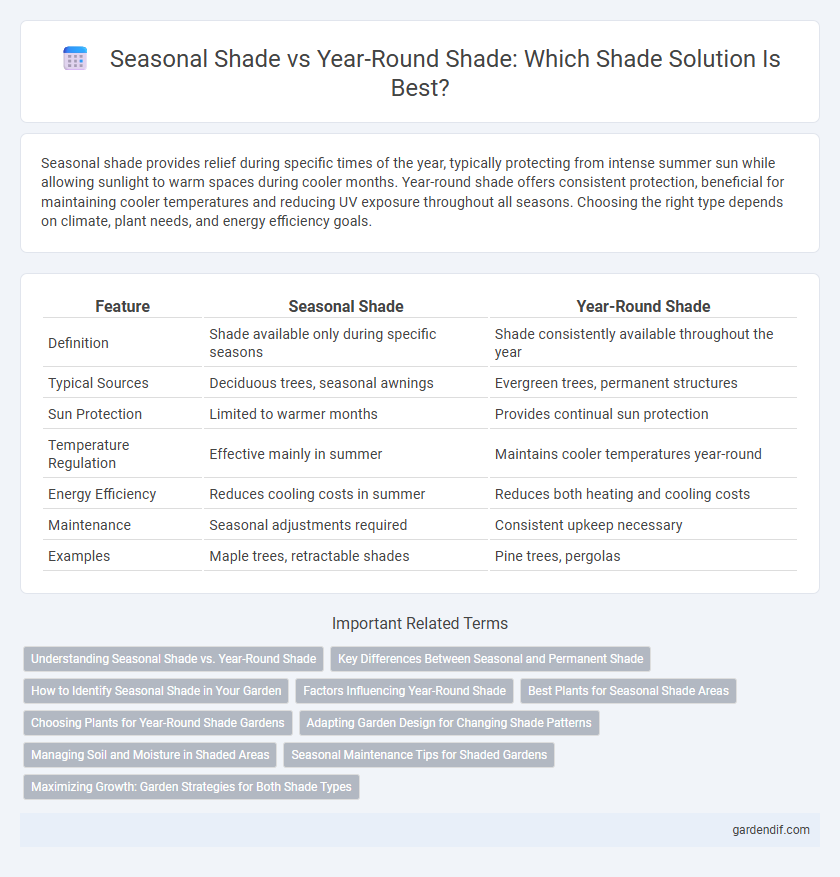
Seasonal Shade vs Year-Round Shade Illustration
Seasonal shade provides relief during specific times of the year, typically protecting from intense summer sun while allowing sunlight to warm spaces during cooler months. Year-round shade offers consistent protection, beneficial for maintaining cooler temperatures and reducing UV exposure throughout all seasons. Choosing the right type depends on climate, plant needs, and energy efficiency goals.
Table of Comparison
| Feature | Seasonal Shade | Year-Round Shade |
|---|---|---|
| Definition | Shade available only during specific seasons | Shade consistently available throughout the year |
| Typical Sources | Deciduous trees, seasonal awnings | Evergreen trees, permanent structures |
| Sun Protection | Limited to warmer months | Provides continual sun protection |
| Temperature Regulation | Effective mainly in summer | Maintains cooler temperatures year-round |
| Energy Efficiency | Reduces cooling costs in summer | Reduces both heating and cooling costs |
| Maintenance | Seasonal adjustments required | Consistent upkeep necessary |
| Examples | Maple trees, retractable shades | Pine trees, pergolas |
Understanding Seasonal Shade vs. Year-Round Shade
Seasonal shade occurs when an area is shaded only during specific times of the year due to the sun's changing position, often influenced by deciduous trees or seasonal structures. Year-round shade provides consistent coverage throughout all seasons, typically created by evergreen trees, permanent structures, or dense foliage. Understanding the difference helps in landscape planning, ensuring optimal plant growth, energy efficiency, and outdoor comfort based on specific shade requirements.
Key Differences Between Seasonal and Permanent Shade
Seasonal shade occurs during specific months when trees or structures block sunlight, typically providing relief during hot summer periods. Year-round shade results from permanent elements like evergreen trees or built environments that consistently limit sun exposure throughout the entire year. The key difference lies in duration and reliability, with seasonal shade offering temporary cooling benefits, while permanent shade ensures constant protection from sunlight.
How to Identify Seasonal Shade in Your Garden
Seasonal shade in your garden can be identified by noting the movement and position of the sun throughout the year, which causes certain areas to receive sunlight only during specific seasons. Observe the patterns of shadow cast by deciduous trees or structures that lose their blocking effect during winter but provide shade in spring and summer. Tracking sunlight exposure over several weeks in different seasons helps pinpoint which garden zones experience intermittent shade versus consistent year-round coverage.
Factors Influencing Year-Round Shade
Year-round shade depends on factors such as tree species, canopy density, and geographic location, which determine the continuity of shade throughout all seasons. Deciduous trees provide seasonal shade by shedding leaves in fall, whereas evergreen trees maintain foliage year-round, ensuring consistent shade. Sun angle and seasonal sunlight variation also influence the intensity and duration of shade during different times of the year.
Best Plants for Seasonal Shade Areas
Seasonal shade areas benefit from plants like hostas, astilbes, and ferns that thrive during partial sun periods and cooler temperatures. These plants adapt well to fluctuating light conditions, promoting healthy growth and vibrant foliage in spring and fall. For optimal results, choose species known for resilience to intermittent sunlight and seasonal moisture variations.
Choosing Plants for Year-Round Shade Gardens
Selecting plants for year-round shade gardens requires focusing on shade-tolerant species that thrive despite low light conditions across all seasons. Evergreen shrubs like boxwood and ferns such as the maidenhair fern maintain greenery and texture throughout the year, ensuring consistent visual interest. Incorporating shade-loving perennials like hostas and hellebores provides seasonal blooms and foliage variation, making the garden vibrant in every season.
Adapting Garden Design for Changing Shade Patterns
Seasonal shade varies throughout the year due to the sun's changing angle, influencing plant selection and placement in garden design. Year-round shade requires choosing shade-tolerant species and utilizing structural elements like pergolas or shade cloth to maintain consistent coverage. Adapting garden design for these patterns enhances plant health and aesthetic appeal by aligning with natural light conditions.
Managing Soil and Moisture in Shaded Areas
Managing soil and moisture in shaded areas requires understanding the differences between seasonal shade and year-round shade, as light exposure directly impacts soil temperature and moisture retention. Seasonal shade allows for periodic sunlight, preventing soil from becoming excessively damp, while year-round shade often leads to consistently cooler, wetter soil conditions that may require improved drainage and organic matter amendment to avoid root rot. Adjusting irrigation schedules and integrating shade-tolerant ground covers can optimize moisture levels and support healthy plant growth in diverse shaded environments.
Seasonal Maintenance Tips for Shaded Gardens
Seasonal shade in gardens requires timely maintenance such as pruning to prevent overcrowding and enhance airflow, while year-round shaded gardens benefit from consistent moisture monitoring to avoid root rot. Use shade-tolerant plants like hostas and ferns for year-round shade and adjust watering schedules seasonally to reduce water stress during dry months. Mulching helps retain soil moisture and regulate temperature in both seasonal and permanent shaded areas, promoting healthy plant growth.
Maximizing Growth: Garden Strategies for Both Shade Types
Maximizing growth in gardens requires tailored strategies for seasonal shade and year-round shade environments. Plants like hostas and ferns thrive in seasonal shade by taking advantage of sunlight during open seasons, while shade-tolerant species such as azaleas and boxwoods excel in year-round shaded areas due to their adaptive foliage and root systems. Incorporating soil amendments and strategic pruning enhances nutrient uptake and light penetration, optimizing plant health regardless of shade type.
Seasonal Shade vs Year-Round Shade Infographic

 gardendif.com
gardendif.com